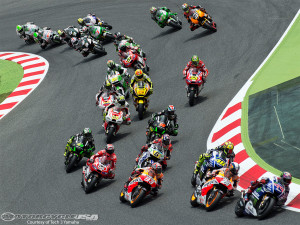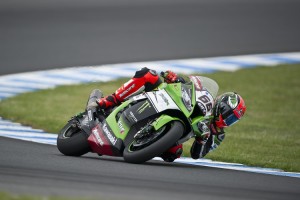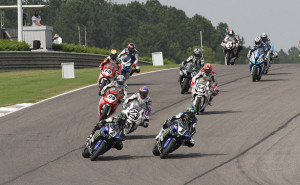I have always looked at corners and wondered of the stories they tell. I’ve never just seen tarmac or pavement, there is so much more to it. Choosing a line in a corner is such a personal choice. There are a lot of things that can determine your fastest, safest and most fun way through. But…
- How do we ultimately choose the line we choose?
- What are the main ingredients to finding the right way through any corner?
- And, does every bike go through a turn the same way?
 These are just some of the questions we answer during a 2 Day STAR School, check out the event schedule and find a date that works for you.
These are just some of the questions we answer during a 2 Day STAR School, check out the event schedule and find a date that works for you.
In this picture, how many different lines can you see?
Can you put your bike in any one of those lines and successfully complete the corner?
So first, let’s talk about the different factors that play into how we determine a line.
What comes before or after a corner; are you coming from a fast straight or are you leading onto one? Is it a fast or slow corner? What part of the corner is the most important to be fast in? All questions you have to answer. One thing you never want to be is one dimensional when choosing a line. After all, wouldn’t it be great to be able to put your bike anyplace on the racetrack or road at anytime? When it comes right to it, there are many ways to take the corners that these track designers throw at us. I have been lucky enough to go through some of the most famous corners in the world and I always adopted one simple solution.
Keep reading to find out what that is.
I have heard a thousand times “follow me and I will show you the race line”. That is so funny to me. What is the “race line” or “fast line”? It’s so open for interpretation. Someone with 100 track days may do things a bit different compared to someone who is at their first track day, wouldn’t you agree?
 The key ingredients to finding your best line are two simple things, speed and lean angle. Without these two working together finding a line can be difficult. For instance, a line you may see Tom Sykes riding in WSBK may not be the best place for a new track day rider to begin. Obviously the speed and lean angle Tom creates will be far advanced to most riders that treat track days as hobbies. Starting wide into a corner to open up the radius only to find that your lean angle won’t allow you to get to the apex is a recipe for disaster. When that panic sets in our instinct is to upright the bike, which now runs us out of track or road.
The key ingredients to finding your best line are two simple things, speed and lean angle. Without these two working together finding a line can be difficult. For instance, a line you may see Tom Sykes riding in WSBK may not be the best place for a new track day rider to begin. Obviously the speed and lean angle Tom creates will be far advanced to most riders that treat track days as hobbies. Starting wide into a corner to open up the radius only to find that your lean angle won’t allow you to get to the apex is a recipe for disaster. When that panic sets in our instinct is to upright the bike, which now runs us out of track or road.
HERE IT IS…
The best way to choose a line is to work from mid track out. It is something I have done my whole career. As my speed picks up I can open my entry to the corner. This allows me to not have to hold the brake lever on or run deeper into the corner on a tight line to make the turn. I also will get to self evaluate my progress each lap doing it this way. As you progress to the point where you find your greatest lean angle, your next goal is to be there for the shortest period of time you can. Most people I see enter corners way to wide but don’t have the lean to find a proper apex and end up riding 8 feet from the inside edge of the track. This now closes off their exit, all bad things. If they would have entered just a bit tighter and found an apex, their risk levels will go down as they twist the throttle on exit allowing the bike to be stood up and driving off the corner (I am a big believer in exits and will address that in a future column).
 What I want you to do is look at the track differently. Find ways of getting into the corner and asking yourself how much more lean can I achieve. Leaning a motorcycle is important because it helps you turn. So, once you find your greatest lean angle you want to stay there for the shortest time possible but without knowing what that lean angle is, our lines will be compromised a bit. Start from the middle of the track and work yourself gradually out and you will discover that not all corners are the same. You’ll discover, not every corner is a wide entry. These are all things we work on at a 2 Day STAR School. Come join us and learn how to be a better, safer, more confident rider.
What I want you to do is look at the track differently. Find ways of getting into the corner and asking yourself how much more lean can I achieve. Leaning a motorcycle is important because it helps you turn. So, once you find your greatest lean angle you want to stay there for the shortest time possible but without knowing what that lean angle is, our lines will be compromised a bit. Start from the middle of the track and work yourself gradually out and you will discover that not all corners are the same. You’ll discover, not every corner is a wide entry. These are all things we work on at a 2 Day STAR School. Come join us and learn how to be a better, safer, more confident rider.
Beware of the “racer line” it could be doing you more harm than good.
Ride safe,
JP



Jason,
Great website, excellently done, clear, inviting, educational, anticipate this is helping your business.
All the best to you and your team.
This was a fabulous era for me. Miss everything related to those racing days. But… daughter getting married, and I am a SoAm farmer! haha.
All blessings my friend. Keep teaching safe riding!
Doug
Doug,
It was so much fun riding with you back in the day. You’ve always been such a supporter of what I have done, thank you so much. Would love to run into you again somewhere soon and thanks for chiming in on the piece. We are working hard to make STAR better all the time.
Cheers,
JP
Mid-track and work your way out has been a big help for me JP. Many times the race line at slow speed is too hard for new riders. This year I am using more track on corners but that is a biproduct of more track time and being smoother which has meant added speed.
Thank you for reminding me of this very valuable lesson. I will be putting it to use at NJMP Thunderbolt this weekend!
Jeremy
Jeremy,
How did Thunderbolt go? Thank you for commenting on my article. So pumped that working from the inside out regarding lines has made sense for you. I agree with teaching new riders what the “race line” is isn’t realistic. What’s great about what you wrote is that you have self evaluated your riding and now started moving lines around a bit. You’re getting faster!!!!
Hope we get to ride again soon,
JP
Your articles are very informative. Thank you
Ronnie,
Thank you so much for throwing me a comment. I am glad you are enjoying reading a few things that I have been writing.
Cheers,
JP
Great stuff! Thanks Jason 🙂
Daniel,
Thanks for the props, means a lot. Ive been having fun doing a bit of writing.
Cheers,
JP
Thanks for the great articles, helps to keep me grounded and focused on the basics in order to get smoother which equals faster. Look forward to hitting some of your schools in the midwest in 2016.
Barry
Barry,
Couldn’t agree with you more on your comments. Continuing to work on our fundamentals will let us see better results quicker. I know we all want to get faster but we can’t put the cart before the horse in our sport otherwise it will bite us.
Looking forward to hooking up next year when we start traveling again.
Cheers,
JP
One tip I really found useful from Jason was to look at every corner combination and make sure I was using the track to its best advantage to keep my speed up. He first introduced me to this concept at his Star School at Spring Mountain where corner 2 is a long left hander and you enter the corner pretty tight to allow the bike to scrub off speed as you let the bike drift out a bit and then come back for the apex and exit allowing you to get on the gas hard. I have used this technique in many corners including corner 2 at Laguna. But where I really noticed the difference was at Miller Motorsports Park in UT. Most track day riders coming out of the corner prior to the final clubhouse turn would delay getting on the throttle to keep turning the bike right to get to the right hand side where I was able to get on the gas much earlier and shoot across the track for a tight entry into the last corner but I was on the gas much earlier resulting in much faster speed and shorter distance and allowing me to pass very easily. I can’t wait to take one of the new courses…….K
Karl,
Great to hear from you, been way to long. I love reading what you wrote, those days at Pahrump were so fun. I rode there again about 5 months ago, you wouldn’t recognize the place. Its still really good but has expanded a ton, like 4-5 tracks out there now.
Hope to see you again soon mate and thanks for commenting on the post.
JP
Major thanks for the post.Much thanks again. Will read on…